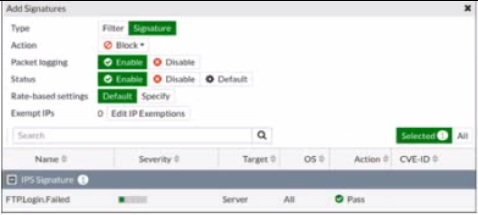At ValidExamDumps, we consistently monitor updates to the Fortinet NSE4_FGT-7.2 exam questions by Fortinet. Whenever our team identifies changes in the exam questions,exam objectives, exam focus areas or in exam requirements, We immediately update our exam questions for both PDF and online practice exams. This commitment ensures our customers always have access to the most current and accurate questions. By preparing with these actual questions, our customers can successfully pass the Fortinet NSE 4 - FortiOS 7.2 exam on their first attempt without needing additional materials or study guides.
Other certification materials providers often include outdated or removed questions by Fortinet in their Fortinet NSE4_FGT-7.2 exam. These outdated questions lead to customers failing their Fortinet NSE 4 - FortiOS 7.2 exam. In contrast, we ensure our questions bank includes only precise and up-to-date questions, guaranteeing their presence in your actual exam. Our main priority is your success in the Fortinet NSE4_FGT-7.2 exam, not profiting from selling obsolete exam questions in PDF or Online Practice Test.
Refer to the exhibit.
Refer to the FortiGuard connection debug output.

Based on the output shown in the exhibit, which two statements are correct? (Choose two.)
FortiGate Security 7.2 Study Guide (p.287-288): 'Flags: D (IP returned from DNS), I (Contract server contacted), T (being timed), F (failed)' 'By default, FortiGate is configured to enforce the use of HTTPS port 443 to perform live filtering with FortiGuard or FortiManager. Other ports and protocols are available by disabling the FortiGuard anycast setting on the CLI.'
Which two statements are correct regarding FortiGate FSSO agentless polling mode? (Choose two.)
Fortigate Infrastructure 7.0 Study Guide P.272-273
https://kb.fortinet.com/kb/documentLink.do?externalID=FD47732
Refer to the exhibit.

Review the Intrusion Prevention System (IPS) profile signature settings. Which statement is correct in adding the FTP.Login.Failed signature to the IPS sensor profile?
Select Block to silently drop traffic matching any of the signatures included in the entry. So, while the default action would be 'Pass' for this signature the administrator is specifically overriding that to set the Block action. To use the default action the setting would have to be 'Default'.
FortiGate Security 7.2 Study Guide (p.394): 'Select Allow to allow traffic to continue to its destination. Select Monitor to allow traffic to continue to its destination and log the activity. Select Block to silently drop traffic matching any of the signatures included in the entry. Select Reset to generate a TCP RST packet whenever the signature is triggered. Select Default to use the default action of the signatures.' 'If you enable Packet logging, FortiGate saves a copy of the packet that matches the signature.'
Action is drop, signature default action is listed only in the signature, it would only match if action was set to default.
Which two statements are true when FortiGate is in transparent mode? (Choose two.)
attachID=Fortigate_Transparent_Mode_Technical_Guide_FortiOS_4_0_version1.2.pdf&documentID=FD33113